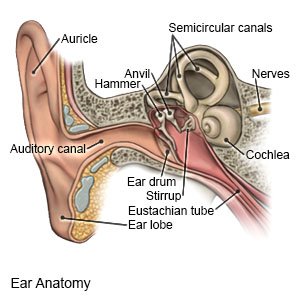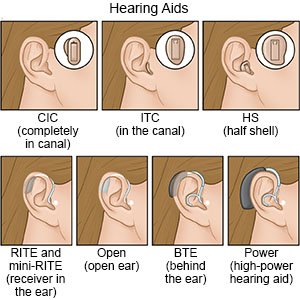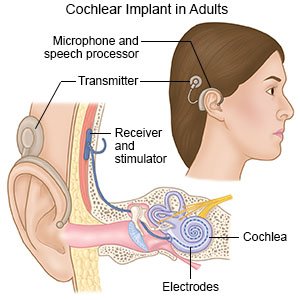Otosclerosis
Medically reviewed by Drugs.com. Last updated on May 6, 2024.
What is otosclerosis?
Otosclerosis is a condition that causes too much bone to grow in part of the ear. The extra bone causes a bone in the middle ear called the stapes to become rigid and stop vibrating. Sound moves as vibration from one part of the ear to another. If the stapes cannot vibrate, sound cannot move further into the ear. This means you will not be able to hear the sound completely. The sound might be muffled, or you might not be able to hear certain sounds at all. Over time, otosclerosis can cause severe or complete hearing loss. Otosclerosis usually affects both ears, but it may affect only one ear.
 |
What increases my risk for otosclerosis?
Pregnancy or a measles infection can make symptoms appear or worsen. Any of the following can increase your risk for otosclerosis:
- Being female
- A family history of otosclerosis
- Fracture of the bones in the ear
- An immune disorder
What are the signs and symptoms of otosclerosis?
Signs and symptoms usually start around age 20 but can start as early as 10 years. Signs and symptoms usually continue to get worse until about age 50. You may have any of the following:
- Slow hearing loss that may start in one ear and move to the other
- Trouble hearing low sounds, such as a whisper
- Hearing more easily in a crowded room with a lot of background noise
- Dizziness, trouble keeping your balance, or vertigo (feeling that you are moving when you are not)
- Tinnitus (ringing or other sounds in the ear)
How is otosclerosis diagnosed?
Your healthcare provider will ask when your symptoms began and if they are getting worse. Tell your provider if anyone in your family has otosclerosis. Tell your provider if you ever had the measles or an ear injury, or if you have an immune disorder. You may also need any of the following:
- A tuning fork may be used to test your hearing. A tuning fork is made of metal. It vibrates and makes noise when it strikes an object. Your healthcare provider will hold the tuning fork to the left and right of your head. Your provider will ask if you can hear the noise and feel the vibration in each ear. This is called air conduction.
- Audiometry is a test used to measure how well you can hear different sounds. You will put on headphones that are attached to a machine. Sounds will be sent through the headphones. You will press a button or raise your hand when you hear the sounds. Each ear will be tested separately. Another device will be placed on bones behind your ears. The device will test how well vibration moves through the bones. This is called bone conduction.
- Tympanometry is a test used to find hearing problems in the middle ear. A device is placed into your ear. The device creates pressure changes that make your eardrum vibrate.
- CT or MRI pictures may be taken of the middle ear. The pictures may show any problems that could be causing your symptoms.
How is otosclerosis treated?
Treatment may not be needed. Your healthcare provider may want you to get a hearing test every year. Treatment depends on the type of otosclerosis you have. If the bones that surround your inner ear are affected, treatment may not be available. This type of otosclerosis is called sensory loss. Conductive loss affects the small bones of the middle ear. Treatment for conductive loss may include any of the following:
- Hearing aids may help you hear low tones more easily. Your healthcare provider can help you choose the right kind of hearing aid for you.

- An assistive listening device can help you hear certain sounds through earphones or a headset. The device may help you hear better when you watch TV, sit in a classroom, or listen to a speaker. Devices are available for telephones and doorbells that use flashing lights or vibration to let you know they are ringing. The devices can be used with hearing aids.
- A cochlear implant may be placed if you have severe hearing loss. A cochlear implant is a device that is put into your cochlea (a part of your inner ear) during surgery. The implant can help you continue to hear certain sounds, but it will not restore normal hearing. Your healthcare provider can tell you if a cochlear implant is right for you. This is based on the type of hearing loss you have.

- Surgery called stapedectomy may be used to remove part or all of your stapes and replace it with an artificial piece. Stapedectomy is used to restore your hearing. Surgery is usually done on one ear at a time.
What can I do to manage my symptoms?
- Protect your hearing. Use ear plugs or ear protectors when you are around loud noises, such as a lawnmower or loud music during a concert. Use foam earplugs that completely block your ear canal. Do not listen to loud music through headphones or earphones.
- Tell others about your hearing loss. You may have trouble hearing another person speak during a conversation. Ask the person to face you when he or she speaks so you can see his or her lips move. Ask the person to speak in a normal tone and volume. Spend time with others in places where you can hear more easily.
Contact your healthcare provider if:
- You have new or worsening symptoms.
- You have questions or concerns about your condition or care.
Care Agreement
You have the right to help plan your care. Learn about your health condition and how it may be treated. Discuss treatment options with your healthcare providers to decide what care you want to receive. You always have the right to refuse treatment. The above information is an educational aid only. It is not intended as medical advice for individual conditions or treatments. Talk to your doctor, nurse or pharmacist before following any medical regimen to see if it is safe and effective for you.© Copyright Merative 2024 Information is for End User's use only and may not be sold, redistributed or otherwise used for commercial purposes.
Further information
Always consult your healthcare provider to ensure the information displayed on this page applies to your personal circumstances.
